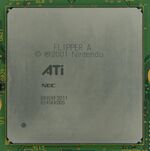GameCube technical specifications
Topic: Engineering
 From HandWiki - Reading time: 5 min
From HandWiki - Reading time: 5 min
Short description: Overview of the technical specifications of the GameCube
Nintendo originally offered a digital video output on early GameCube models. However, it was determined that less than one percent of users utilized the feature. The company eventually removed the option starting with model number DOL-101 of May 2004.[1] The console's technical specifications are as follows.[2][3][4]
| Details | Source(s) | |
|---|---|---|
| CPU |
|
[5][6] |
| GPU |
|
[5][6][10] |
| System Memory |
|
[6][11][10] |
| Audio |
|
[5][11] |
| Video Modes |
|
[5] |
| Connectivity |
|
[5]Template:BSN |
| Storage |
|
[5][11][13] |
| Other |
|
[11] |
References
- ↑ "Nintendo's GameCube Component FAQ page". Nintendo. https://www.nintendo.com/consumer/systems/nintendogamecube/component_faq.jsp.
- ↑ 2.0 2.1 2.2 "DCTP - Nintendo's Gamecube Technical Overview". http://www.segatech.com/gamecube/overview/.
- ↑ "Console Specs". http://www.angelfire.com/electronic2/mariotan/.
- ↑ IGN Staff (November 4, 2000). "Gamecube Versus PlayStation 2". IGN. http://ign.com/articles/2000/11/04/gamecube-versus-playstation-2.
- ↑ 5.0 5.1 5.2 5.3 5.4 5.5 5.6 5.7 Shimpi, Anand Lal (December 7, 2001). "Hardware Behind the Consoles - Part II: Nintendo's GameCube". AnandTech. http://www.anandtech.com/show/858.
- ↑ 6.0 6.1 6.2 "Game Consoles: A Look Ahead". Ace's Hardware. December 14, 2003. http://www.aceshardware.com/read.jsp?id=60000288.
- ↑ 7.0 7.1 7.2 7.3 Graphics Processor Specifications, IGN, 2001
- ↑ IGN Staff (January 17, 2001). "GameCube 101: Graphics". IGN. http://ign.com/articles/2001/01/17/gamecube-101-graphics.
- ↑ "X-ing Things Out". January 9, 2001. https://www.ign.com/articles/2001/01/09/x-ing-things-out.
- ↑ 10.0 10.1 GameCube clears path for game developers, EE Times, 5/16/2001
- ↑ 11.0 11.1 11.2 11.3 "GCN Technical Specifications". Nintendo. http://register.nintendo.com/techspecgcn.
- ↑ "| Nintendo - Customer Service - Memory Card 1019 |". https://www.nintendo.com/consumer/memorycard1019.jsp.
- ↑ "Nintendo GameCube Accessories". Nintendo. https://www.nintendo.co.uk/NOE/en_GB/systems/accessories_1222.html. (dead)
 |
Licensed under CC BY-SA 3.0 | Source: https://handwiki.org/wiki/Engineering:GameCube_technical_specifications1 | Status: cached on July 16 2024 12:17:31↧ Download this article as ZWI file
 KSF
KSF




